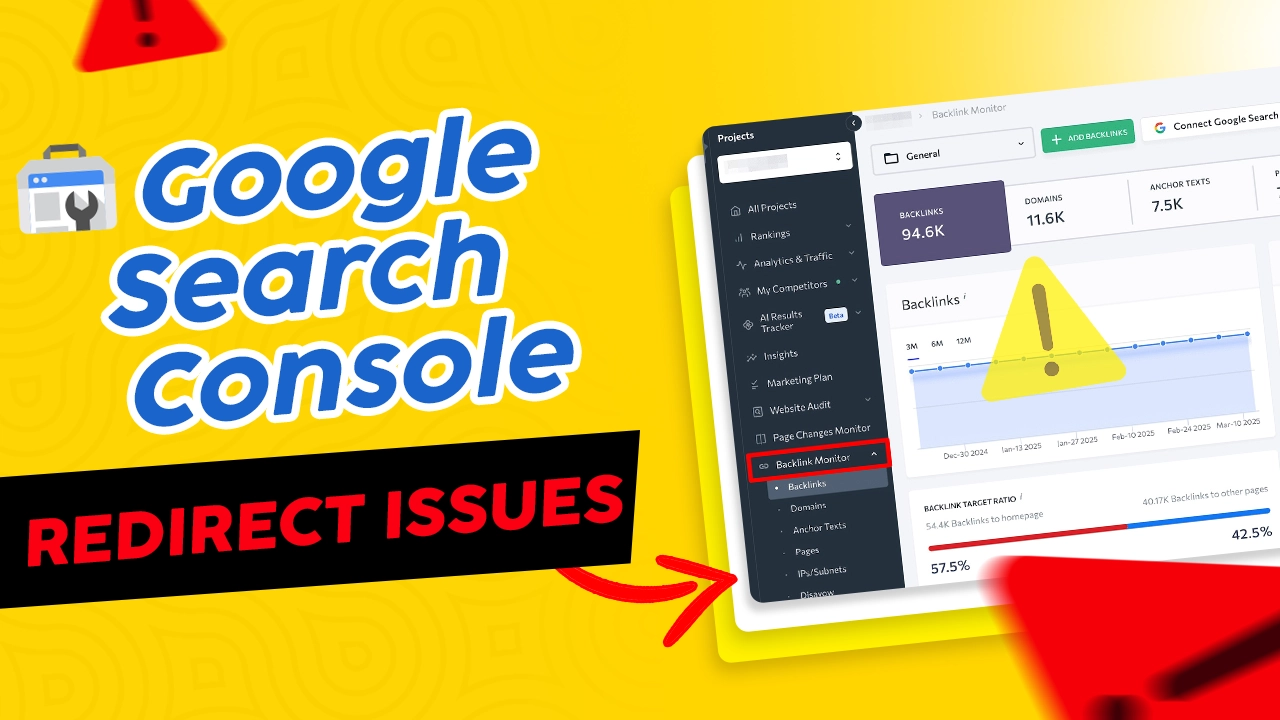Google Search Console Redirect Issues: The Complete Guide to Understanding and Fixing Them

If you’ve received a notification about redirect issues in Google Search Console, you’re not alone. This is one of the most common SEO problems website owners face, and it often leaves them confused—especially when they think they don’t have any redirects on their site.
In this comprehensive guide, we’ll break down everything you need to know about redirect issues, why they appear even on sites without obvious redirects, and most importantly, how to fix them.
What Are Redirect Issues in Google Search Console?
Google Search Console flags redirect issues when it encounters pages that don’t serve content directly but instead redirect visitors (and Googlebot) to other pages. These issues typically appear in the “Page indexing” report under categories like:
- Page with redirect: The page redirects to another page
- Redirect error: The redirect doesn’t work properly
- Redirect loop: Pages redirect in a circle, creating an endless loop
Why Do Redirect Issues Appear When You “Don’t Have Redirects”?
This is the million-dollar question most website owners ask. The truth is, your website likely has more redirects than you realize. Here’s where they commonly come from:
1. Automatic Server-Level Redirects
Your web hosting provider or server configuration automatically creates redirects for:
- HTTP to HTTPS: All non-secure pages redirect to secure versions
- WWW to non-WWW (or vice versa): Canonicalization redirects
- Trailing slash redirects: /page redirects to /page/
- Case sensitivity: Some servers redirect uppercase URLs to lowercase
2. Content Management System (CMS) Redirects
Popular platforms create redirects automatically:
- WordPress: Changes to permalinks, slug modifications, or plugin-generated redirects
- Shopify: Product URL changes, collection updates
- Wix/Squarespace: Page moves or renames
- Drupal/Joomla: URL alias changes
3. Plugin and Extension Redirects
Common plugins that create redirects:
- SEO plugins (Yoast, RankMath, All in One SEO)
- Redirect management plugins (Redirection, Simple 301 Redirects)
- Security plugins that redirect suspicious traffic
- Caching plugins that optimize URL structures
4. CDN and Security Service Redirects
Third-party services add redirects:
- Cloudflare: Security rules, page rules, or optimization features
- AWS CloudFront: Distribution settings
- Security services: Bot protection or geographic redirects
5. Historical Website Changes
Past modifications create lasting redirects:
- Website migrations: Old URLs still indexed by Google
- URL structure changes: Previous permalink modifications
- Deleted pages: Redirects to prevent 404 errors
- Campaign-specific pages: Temporary redirects that became permanent
The SEO Impact of Redirect Issues
Understanding how redirects affect your website’s SEO performance is crucial for prioritizing fixes.
Negative SEO Impacts
- Crawl Budget Waste Google allocates a specific crawl budget to your website. When Googlebot encounters redirects, it uses this budget following redirect chains instead of discovering and crawling new content.
- Page Loading Speed Each redirect adds server response time. Multiple redirects can significantly slow down page loading, affecting both user experience and Core Web Vitals scores.
- Link Equity Dilution While 301 redirects pass most link equity (PageRank), redirect chains can cause some loss. A page that redirects through multiple steps loses more authority than a direct link.
- Indexing Delays Pages with redirect issues may take longer to be indexed or re-indexed, delaying the visibility of your content updates.
- User Experience Problems Slow-loading pages due to redirects increase bounce rates and decrease user satisfaction, indirectly affecting SEO rankings.
When Redirects Help SEO
Not all redirects are bad. Properly implemented redirects:
- Preserve link equity when moving pages
- Consolidate duplicate content issues
- Maintain user experience during site restructuring
- Prevent 404 errors for changed URLs
How to Identify and Analyze Redirect Issues
Step 1: Access Your Search Console Data
- Log into Google Search Console
- Navigate to Indexing > Pages
- Scroll to the “Why pages aren’t indexed” section
- Click on “Page with redirect” or “Redirect error”
- Export the list of affected URLs
Step 2: Analyze Redirect Patterns
Look for common patterns in your redirect issues:
- Are they all from a specific section of your site?
- Do they follow a particular URL structure?
- Are they related to recent site changes?
Step 3: Use Redirect Checking Tools
Free Tools:
- Redirect-checker.org: Check individual URLs
- HTTPStatus.io: Bulk redirect checking
- Browser developer tools: Network tab shows redirect chains
Paid Tools:
- Screaming Frog SEO Spider: Comprehensive site crawling
- Ahrefs Site Audit: Redirect analysis as part of technical SEO
- SEMrush Site Audit: Identifies redirect issues and chains
Step-by-Step Guide to Fix Redirect Issues
Phase 1: Quick Assessment
1. Categorize Your Redirects
- Necessary redirects: HTTP to HTTPS, www canonicalization
- Unnecessary redirects: Fixable internal linking issues
- Broken redirects: Need immediate attention
2. Prioritize by Impact
- High-traffic pages first
- Important landing pages
- Pages with many inbound links
- Revenue-generating pages
Phase 2: Technical Fixes
1. Eliminate Redirect Chains
Problem: Page A → Page B → Page C Solution: Direct redirect from Page A → Page C
How to fix:
- Update .htaccess rules (Apache servers)
- Modify server configuration (Nginx)
- Update CMS redirect settings
- Adjust plugin configurations
2. Update Internal Links
Instead of linking to URLs that redirect, update your internal links to point directly to the final destination.
Common places to update:
- Navigation menus
- Footer links
- Internal content links
- Image links
- Call-to-action buttons
3. Clean Up XML Sitemaps
Your XML sitemap should only contain final destination URLs, not redirecting pages.
Steps:
- Review your sitemap.xml file
- Remove any URLs that redirect
- Submit the updated sitemap to Search Console
- Request re-indexing if necessary
4. Fix Canonical Tag Issues
Ensure canonical tags point to the correct final URLs, not redirecting pages.
Phase 3: Platform-Specific Solutions
WordPress Sites:
- Review permalink structure changes
- Check redirect plugins (Yoast, Redirection plugin)
- Examine .htaccess file modifications
- Update internal links in posts and pages
Shopify Sites:
- Review product and collection URL changes
- Check theme customizations
- Update navigation and internal links
- Review app-generated redirects
Custom Sites:
- Audit server configuration files
- Review application-level redirects
- Check database entries for URL changes
- Update hardcoded links in templates
Advanced Redirect Management
Setting Up Proper 301 Redirects
When you need to redirect a page permanently:
Apache (.htaccess):
Redirect 301 /old-page.html https://example.com/new-page.html
Nginx:
location = /old-page.html {
return 301 https://example.com/new-page.html;
}
WordPress (functions.php):
function custom_redirect() {
if (is_page(‘old-page’)) {
wp_redirect(‘https://example.com/new-page/’, 301);
exit();
}
}
add_action(‘template_redirect’, ‘custom_redirect’);
Monitoring and Maintenance
1. Regular Audits
- Monthly redirect checks using crawling tools
- Quarterly comprehensive site audits
- Monitor Search Console for new redirect issues
2. Documentation
- Keep a record of all redirects implemented
- Document the reason for each redirect
- Set review dates for temporary redirects
3. Performance Monitoring
- Track page load times for redirected pages
- Monitor crawl budget usage in Search Console
- Watch for increases in redirect-related issues
Prevention Strategies
1. Plan URL Changes Carefully
Before making URL changes:
- Consider the SEO impact
- Plan redirect strategy
- Update internal links simultaneously
- Communicate changes to your team
2. Use Staging Environments
Test all changes in a staging environment before implementing on live sites to catch redirect issues early.
3. Implement Proper Change Management
- Document all URL structure changes
- Create redirect maps for migrations
- Set up monitoring for new redirect issues
- Train team members on redirect best practices
4. Regular Technical SEO Audits
Include redirect analysis in your regular SEO audits to catch issues before they impact performance significantly.
When to Seek Professional Help
Consider consulting with an SEO professional or developer when:
- You have hundreds of redirect issues
- Redirect problems persist after attempted fixes
- You’re planning a major site migration
- Technical server-level changes are required
- You’re unsure about the impact of removing redirects
Measuring Success
After implementing fixes, monitor these metrics:
Google Search Console:
- Reduction in “Page with redirect” errors
- Improved crawl efficiency
- Faster indexing of new content
Performance Metrics:
- Page load speed improvements
- Reduced server response times
- Better Core Web Vitals scores
SEO Metrics:
- Maintenance or improvement in rankings
- Increased organic traffic
- Better user engagement metrics
Key Takeaways
- Redirects are often invisible: Many redirects exist at the server or platform level without explicit creation
- Not all redirects are bad: Some redirects are necessary for proper site function
- Focus on chains and loops: These cause the most significant SEO problems
- Update internal links: This provides the quickest wins for redirect optimization
- Regular monitoring is essential: Redirect issues can reappear with site changes
- Document everything: Keep records of redirects for future reference
Final Thoughts
Redirect issues in Google Search Console might seem overwhelming, but they’re manageable with the right approach. Start by understanding where your redirects come from, prioritize the most impactful fixes, and implement a systematic approach to resolution.
Remember that some redirects are necessary and beneficial for your website. The goal isn’t to eliminate all redirects but to ensure they’re properly implemented and serving their intended purpose without creating unnecessary complexity for search engines or users.
By following this guide and maintaining regular monitoring practices, you can keep redirect issues under control and ensure they don’t negatively impact your website’s SEO performance.






